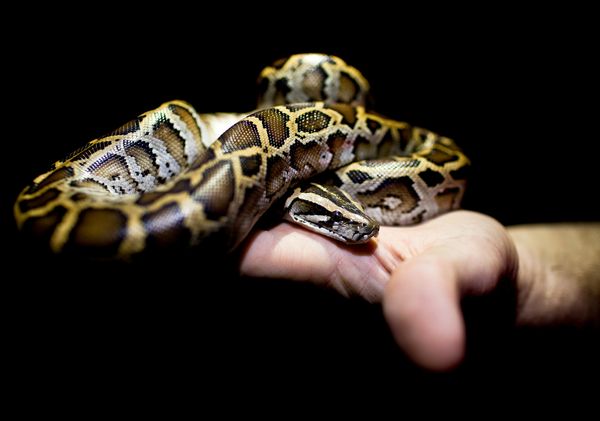Florida Python Hunt Captures 68 Invasive Snakes
A young Burmese python found in the Florida Everglades on January 14 during the Python Challenge.
It's a wrap—the 2013 Python Challenge has nabbed 68 invasive Burmese pythons in Florida, organizers say. And experts are surprised so many of the elusive giants were caught.
Nearly 1,600 people from 38 states—most of them inexperienced hunters—registered for the chance to track down one of the animals, many of which descend from snakes that either escaped or were dumped into the wild.
Since being introduced, these Asian behemoths have flourished in Florida's swamps while also squeezing out local populations of the state's native mammals, especially in the Everglades.
To highlight the python problem, the Florida Fish and Wildlife Conservation Commission and its partners launched the 2013 Python Challenge, which encouraged registered participants to catch as many pythons as they could between January 12 and February 10 in state wildlife-management areas within the Everglades.
The commission gave cash prizes to those who harvested the most and longest pythons.
Frank Mazzotti, a wildlife ecologist at the University of Florida and scientific leader for the challenge, said before the hunt that he would consider a harvest of 70 animals a success—and 68 is close enough to say the event met its goals.
It's unknown just how many Burmese pythons live in Florida, but catching 68 snakes is an "exceptional" number, added Kenneth Krysko, senior herpetologist at the Florida Museum of Natural History in Gainesville.
Snakes in the Grass
Finding 68 snakes is impressive, experts say, since it's so hard to find pythons. For one, it's been unusually warm lately in Florida, which means the reptiles—which normally sun themselves to regulate their body temperature—are staying in the brush, making them harder to detect, Krysko said.
On top of that, Burmese pythons are notoriously hard to locate, experts say.
The animals are so well camouflaged that people can stand right next to one and not notice it. "It's rare that you get to see them stretched out—most of the time they're blending in," said Cheryl Millett, a biologist at the Nature Conservancy, a Python Challenge partner.
What's more, the reptiles are ambush hunters, which means they spend much of their time lying in wait in dense vegetation, not moving, she said.
That's why Millett gave the hunters some tips, such as looking along the water's edge, where the snakes like to hang out, and also simply listening for "something big moving through the vegetation."
Even so, catching 68 snakes is "actually is a little more than I expected," said Millett.
No Walk in the Park
Ruben Ramirez, founder of the company Florida Python Hunters, won two prizes in the competition: First place for the most snakes captured—18—and second place for the largest python, which he said was close to 11 feet (3.4 meters) long. The biggest Burmese python caught in Florida, nabbed in 2012, measured 17.7 feet (5.4 meters).
"They're there, but they're not as easy to find as people think," said Ramirez. "You're not going to be stumbling over pythons in Miami."
All participants, some of whom had never hunted a python before, were trained to identify the difference between a Burmese python and Florida's native snakes, said Millett. No native snakes were accidentally killed, she said.
Hunters were also told to kill the snakes by either putting a bolt or a bullet through their heads, or decapitating them-all humane methods that result "in immediate loss of consciousness and destruction of the brain," according to the Python Challenge website.
Ramirez added that some of the first-time or amateur hunters had different expectations. "I think they were expecting to walk down a canal and see a 10-foot [3-meter], 15-foot [4.5-meter] Burmese python. They thought it'd be a walk in the park."
Stopping the Spread
Completely removing these snakes from the wild isn't easy, and some scientists see the Python Challenge as helping to achieve part of that goal.
"You're talking about 68 more animals removed from the population that shouldn't be there—that's 68 more mouths that aren't being fed," said the Florida museum's Krysko. (Read about giant Burmese python meals that went bust.)
"I support any kind of event or program that not only informs the general public about introduced species, but also gets the public involved in removing these nonnative animals that don't belong there."
The Nature Conservancy's Millett said the challenge had two positive outcomes: boosting knowledge for both science and the public.
Millett runs a public-private Nature Conservancy partnership called Python Patrol that the Florida wildlife commission will take on in the fall. The program focuses not only on eradicating invasive pythons but on preventing the snake from moving to ecologically sensitive areas, such as Key West.
Necropsies on the captured snakes will reveal what pythons are eating, and location data from the hunters will help scientists figure out where the snakes are living—valuable data for researchers working to stop their spread.
"This is the most [number of] pythons that have been caught in this short of a period of time in such an extensive area," said the University of Florida's Mazzotti.
"It's an unprecedented sample, and we're going to get a lot of information out of that."
Christine Dell'Amore and Kate Andries
National Geographic News
Published February 19, 2013












